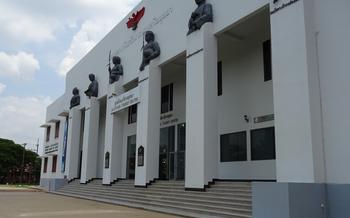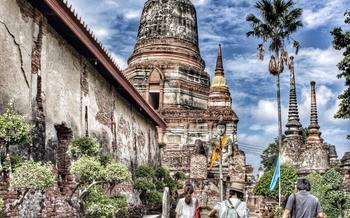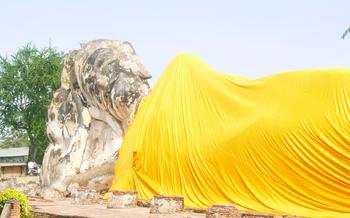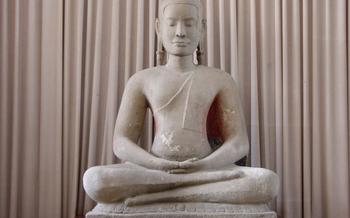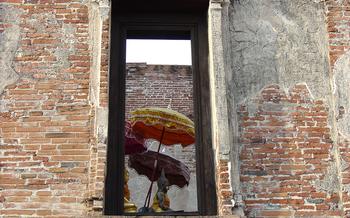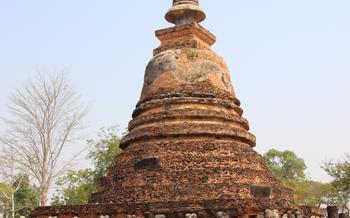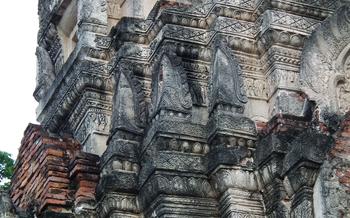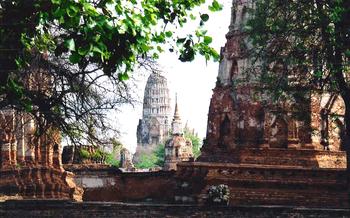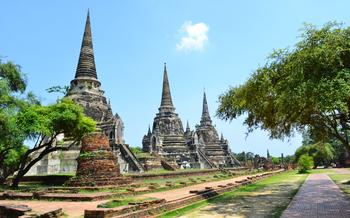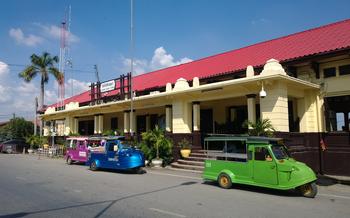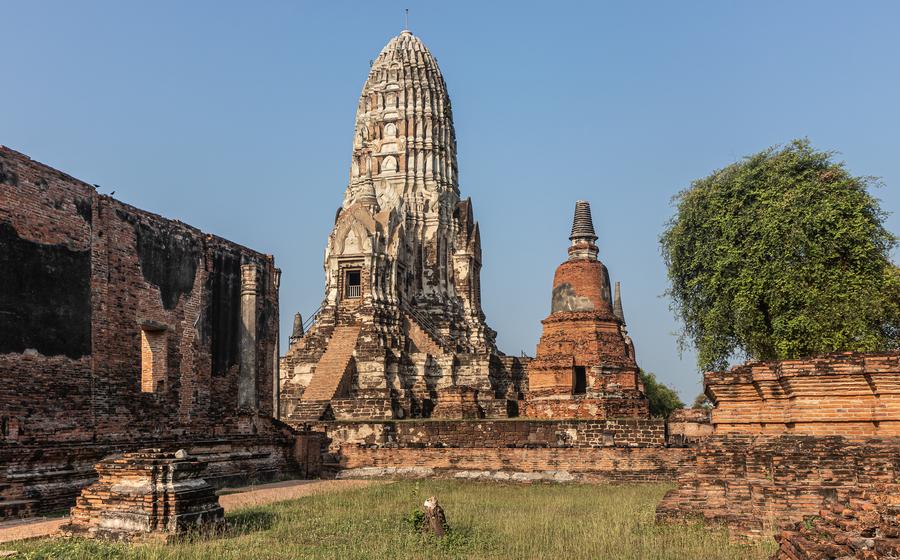
Wat Sena Sanaram
- The Ruins of Wat Sena Sanaram: A Historical Overview
- The Ordination Hall: A Place of Spiritual Significance
- The Surrounding Temples and Monasteries
- Getting to Wat Sena Sanaram: Transportation Options
- Tips for Navigating the Local Transportation System:
- Visiting Hours and Admission Fees
- Dress Code and Etiquette: Respecting Local Customs
- Local Cuisine: Where to Eat Nearby
- Accommodation Options: Where to Stay
- Guided Tours and Local Guides
- Shopping for Souvenirs: Local Markets and Handicrafts
- Combining History with Nature: Nearby Attractions
- Insider Tip: Discovering Hidden Gems
The Ruins of Wat Sena Sanaram: A Historical Overview
Wat Sena Sanaram, an ancient Buddhist temple in Ayutthaya, Thailand, stands as a testament to the grandeur and artistic achievements of the Ayutthaya Kingdom. Its origins can be traced back to the 15th century when King Trailok ordered its construction. The temple served as a royal monastery and a place of learning, hosting monks and scholars from across the kingdom. Over the centuries, Wat Sena Sanaram underwent several renovations and additions, reflecting the evolving architectural styles and religious practices of the time.
In 1767, the Burmese army invaded and sacked Ayutthaya, leaving much of the city in ruins. Wat Sena Sanaram was not spared from destruction, and its structures were largely damaged. Despite its dilapidated state, the temple's significance as a historical and cultural landmark remained, attracting visitors and pilgrims from around the world. In the late 20th century, conservation efforts began to restore and preserve the remaining ruins, allowing visitors to glimpse the former glory of this once-magnificent temple.
The Ordination Hall: A Place of Spiritual Significance
The ordination hall at Wat Sena Sanaram stands as a testament to the temple's spiritual significance. This sacred space was specifically constructed for the purpose of conducting ordination ceremonies, where young men officially become Buddhist monks. The hall's interior is adorned with exquisite murals that depict Buddhist teachings and stories, creating an immersive and awe-inspiring atmosphere. These murals narrate the life of the Buddha, his teachings, and the journey of enlightenment, offering visitors a profound glimpse into the core principles of Buddhism.
During ordination ceremonies, the hall transforms into a solemn and sacred space. The air is filled with the chanting of monks, the aroma of incense, and the gentle sounds of bells. Novices, dressed in white robes, gather before the revered Buddha images, ready to embark on their spiritual journey. The abbot, or head monk, presides over the ceremony, guiding the novices through the rituals and imparting the teachings of the Buddha.
The ordination hall at Wat Sena Sanaram is not just a physical structure but a spiritual sanctuary where young men take their vows and commit to a life of devotion and service. It represents the continuity of the Buddhist tradition, ensuring that the teachings of the Buddha continue to be passed down from generation to generation.
The Surrounding Temples and Monasteries
Wat Sena Sanaram is not the only temple worth exploring in Ayutthaya. The city is home to numerous other temples and monasteries, each with its unique history and features. Some notable temples nearby include:
-
Wat Mahathat: Located just a short walk from Wat Sena Sanaram, Wat Mahathat is one of Ayutthaya's most famous and iconic temples. It is known for its massive prang, or central spire, which is surrounded by numerous Buddha images.
-
Wat Phra Si Sanphet: This temple was once the royal temple of the Ayutthaya Kingdom and is considered one of the most important historical sites in the city. It features three large chedi, or stupas, which contain the ashes of several Ayutthaya kings.
-
Wat Yai Chai Mongkhon: Located a bit further from Wat Sena Sanaram, Wat Yai Chai Mongkhon is a large and impressive temple known for its giant reclining Buddha image. The image is over 30 meters long and is one of the largest in Thailand.
Visiting these surrounding temples and monasteries is a great way to learn more about the history and culture of Ayutthaya. Each temple has its own unique stories and legends, and exploring them offers a glimpse into the rich spiritual heritage of this ancient city.
Getting to Wat Sena Sanaram: Transportation Options
Reaching Wat Sena Sanaram is a breeze, with various transportation options available to suit your preferences and budget. The temple is conveniently located within the city limits, making it easily accessible from any part of Ayutthaya.
For those seeking a budget-friendly option, buses are a reliable choice. Simply hop on any bus heading towards the Bang Pa-In district and ask the driver to drop you off at Wat Sena Sanaram. The bus fare is minimal, and the journey takes approximately 30 minutes from the city center.
Taxis are another convenient option, offering a direct and comfortable ride to the temple. Fares are generally reasonable, but be sure to agree on a price before starting your journey. Tuk-tuks, the iconic three-wheeled vehicles, are also a fun and affordable way to get around Ayutthaya. While they may be slower than taxis, they offer a unique local experience.
Tips for Navigating the Local Transportation System:
- Buses in Ayutthaya are typically red double-decker buses. Look for the blue and white sign on the front displaying the destination.
- Taxis are widely available and can be hailed from the street or found at designated taxi stands.
- Tuk-tuks can be found at tourist spots and along main roads. Negotiate the fare before getting in.
- It's helpful to have the temple's name written in Thai to show to the driver if there is a language barrier.
Visiting Hours and Admission Fees
Wat Sena Sanaram welcomes visitors from all over the world, offering an immersive cultural and spiritual experience. The temple is open to the public daily, providing ample opportunities to explore its grounds and soak in its serene atmosphere. Visitors can plan their visit according to their convenience, as the temple remains accessible throughout the week.
Admission to Wat Sena Sanaram is free of charge, allowing travelers to enjoy its wonders without any financial constraints. This open-door policy encourages people from various backgrounds and cultures to experience the temple's beauty and significance. However, donations are gratefully accepted and play a crucial role in maintaining and preserving the temple's historical and cultural heritage. By contributing, visitors can actively support the preservation of this sacred site for future generations.
When planning your visit, it's advisable to avoid peak hours to fully appreciate the temple's tranquility. Early mornings or late afternoons offer a more serene and intimate experience, allowing you to immerse yourself in the temple's spiritual ambiance without the distraction of crowds. Whether you're a history enthusiast, a spiritual seeker, or simply an adventurer, Wat Sena Sanaram promises an unforgettable and rewarding experience.
Dress Code and Etiquette: Respecting Local Customs
When visiting Wat Sena Sanaram, it is essential to dress appropriately and respectfully to honor local customs and traditions. Visitors should opt for modest and conservative attire, covering their shoulders and knees. Avoid wearing revealing clothing, such as shorts, tank tops, or sheer garments. Additionally, it is customary to remove your shoes before entering the temple's sacred spaces, including the ordination hall and the chedi. Remember to maintain a respectful demeanor while exploring the temple grounds, speaking softly and avoiding loud noises. Respecting local customs and traditions is a way of showing gratitude to the Thai people and preserving the sanctity of this sacred site.
Local Cuisine: Where to Eat Nearby
When visiting Wat Sena Sanaram, indulge in the delectable flavors of authentic Thai cuisine at nearby restaurants. Explore local eateries offering a range of dishes that showcase the region's rich culinary heritage.
Must-Try Dishes:
- Pad Thai: A classic stir-fried noodle dish with a sweet and tangy sauce, typically made with shrimp, chicken, or tofu.
- Khao Pad: Fried rice with various ingredients such as vegetables, meat, seafood, and eggs, a popular street food.
- Tom Yum Goon: A spicy and sour soup with shrimp, mushrooms, lemongrass, and galangal, known for its bold flavors.
- Gaeng Daeng: Red curry with meat or vegetables, a fragrant and flavorful dish with a coconut milk base.
- Som Tum: Spicy green papaya salad with tomatoes, carrots, peanuts, and a tangy dressing, a refreshing and popular choice.
Tips for Finding Authentic Eateries:
- Venture into local markets and food stalls to discover hidden culinary gems.
- Look for restaurants frequented by locals, often indicating the authenticity and quality of the food.
- Don't be afraid to try new dishes and flavors, embracing the culinary diversity of Thailand.
- Ask your hotel or guide for recommendations, as they may know hidden spots that tourists might miss.
Accommodation Options: Where to Stay
When planning your visit to Wat Sena Sanaram, choosing the right accommodation is crucial for a comfortable and enjoyable experience. Several hotels and guesthouses are located near the temple, catering to travelers with varying budgets and preferences.
For those seeking luxury and convenience, the Ayutthaya Riverside Hotel is an excellent choice. Situated along the Chao Phraya River, this upscale hotel offers stunning views, elegant rooms, and a range of amenities, including a swimming pool, spa, and fitness center.
For a more budget-friendly option, the Baan Pompetch Guesthouse is a great choice. This cozy guesthouse offers clean and comfortable rooms at an affordable price. It is located within walking distance of Wat Sena Sanaram and other historical sites.
To immerse yourself in the local culture, consider staying at a homestay. Several guesthouses and homestays in Ayutthaya offer a unique opportunity to experience Thai hospitality firsthand. You'll get a chance to interact with local families and learn about their way of life.
When booking your accommodation, consider factors such as proximity to the temple, amenities, and budget. It's advisable to book in advance, especially during peak tourist seasons, to secure your preferred choice.
Guided Tours and Local Guides
Exploring Wat Sena Sanaram with a knowledgeable guide can greatly enhance your experience. Guided tours are available in various languages, providing historical insights, cultural context, and fascinating stories about the temple. Local guides are passionate about their heritage and eager to share their knowledge. They can point out hidden details, explain the significance of rituals and ceremonies, and offer a deeper understanding of the temple's spiritual significance. Booking a guided tour in advance is recommended to secure a spot and avoid disappointment. Look for reputable tour operators with experienced and licensed guides. The cost of guided tours varies depending on the duration, group size, and itinerary. However, the investment is worthwhile, as it allows you to grasp the essence of Wat Sena Sanaram and its profound history.
Shopping for Souvenirs: Local Markets and Handicrafts
After immersing yourself in the history and spirituality of Wat Sena Sanaram, take some time to explore the nearby markets and shops for unique souvenirs and local handicrafts. The area surrounding the temple is a treasure trove of authentic Thai products, allowing you to take home a piece of your Ayutthaya experience.
Look out for intricate Buddha statues, each handcrafted with meticulous attention to detail. These statues are not only decorative pieces but also hold deep religious significance. You can also find an array of amulets, believed to bring good luck, protection, and prosperity. These amulets are often worn as necklaces or bracelets and make for meaningful gifts.
For those who appreciate textiles, the local markets offer a vibrant selection of handmade fabrics, clothing, and accessories. From colorful silk scarves to intricately woven tapestries, these textiles showcase the artistry and craftsmanship of the local people. Bargaining is a common practice in Thai markets, so don't be afraid to negotiate a fair price while supporting the local economy.
When shopping for souvenirs, remember to respect the local culture and customs. Avoid purchasing items that depict Buddha in a disrespectful manner, as this is considered highly offensive. Instead, opt for souvenirs that celebrate the rich history and heritage of Ayutthaya.
Combining History with Nature: Nearby Attractions
Wat Sena Sanaram is not just a historical gem; it's also surrounded by other captivating attractions that blend history with nature. For a comprehensive itinerary, consider visiting the nearby Wat Mahathat, known for its iconic Buddha head entwined by tree roots. Take a leisurely stroll through the Bang Pa-In Royal Palace, a stunning summer palace adorned with beautiful gardens and intricate architecture.
To immerse yourself in the natural beauty of the region, head to the Khao Yai National Park, a UNESCO World Heritage Site. This vast park offers breathtaking landscapes, diverse wildlife, and exciting trekking trails. Don't miss the opportunity to explore the Ayutthaya Historical Park, a sprawling complex of ancient temples and ruins that transport you back in time.
By combining the historical significance of Wat Sena Sanaram with the natural wonders of the surrounding area, you'll create a truly unforgettable travel experience. Remember to plan your itinerary carefully to make the most of your time and explore all that this region has to offer.
Insider Tip: Discovering Hidden Gems
Beyond the main attractions, Wat Sena Sanaram holds hidden gems waiting to be discovered. Venture off the beaten path to stumble upon secluded corners, serene gardens, and lesser-known shrines. Explore the temple's periphery to find ancient stupas shrouded in greenery, each narrating a unique tale from the past. Seek out the hidden Buddha images tucked away in nooks and crannies, radiating an aura of peace and tranquility.
For a truly local experience, engage with the friendly monks who reside within the temple grounds. They are a treasure trove of knowledge and stories, eager to share their insights about the temple's history and significance. Embrace their wisdom and learn about the profound spiritual practices that have taken place within these sacred walls for centuries.
By exploring beyond the obvious, you'll uncover the hidden wonders of Wat Sena Sanaram, gaining a deeper appreciation for its rich history, intricate architecture, and profound spiritual significance. So, embrace your curiosity, wander with an open heart, and let the temple's secrets reveal themselves to you.
